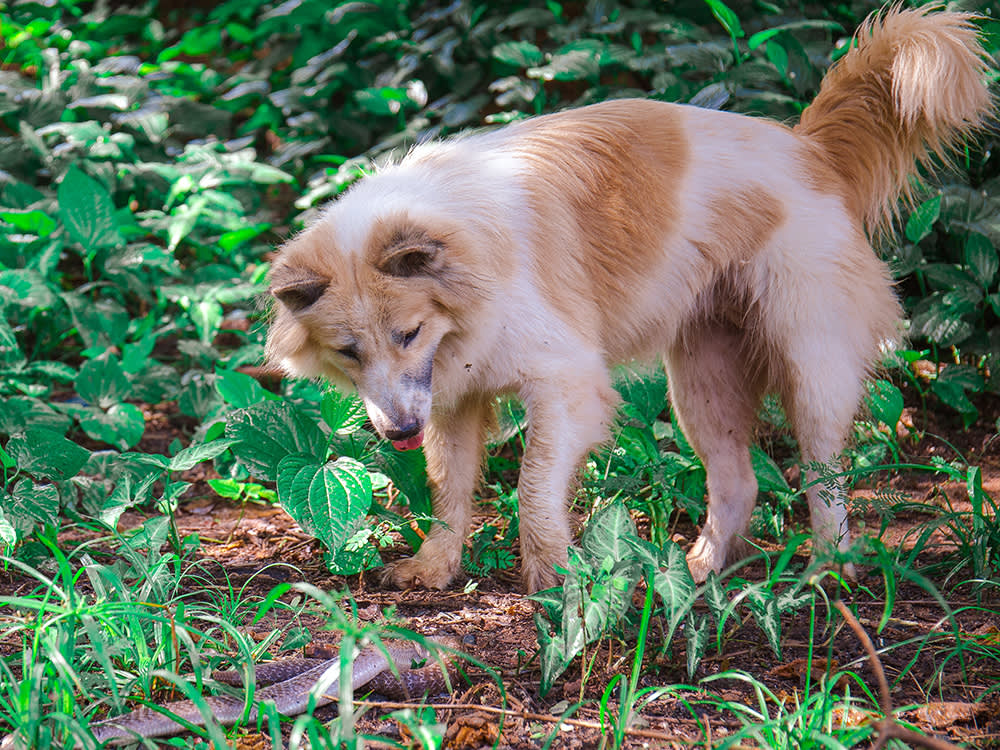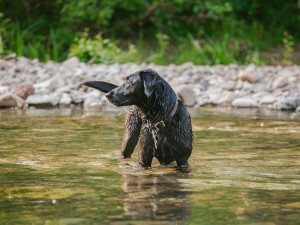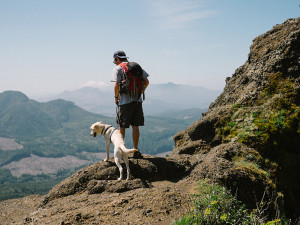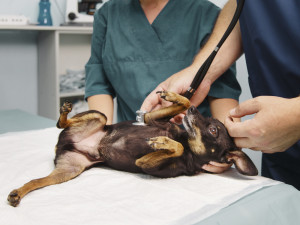What To Do If A Snake Bites Your Dog
Step one: Get your pup to the vet ASAP.

share article

Your pet wants you to read our newsletter. (Then give them a treat.)
If you live in a warmer climate (i.e., California, the Southwest, or Southeast), you probably know to be on the lookout for snakes while you’re out on a hike. Because here’s the thing: You’re on their turf (just like surfers have to be mindful of sharks when they’re riding waves).
Snake bites on dogs (and people) are an emergency situation. You should seek treatment from a veterinarian ASAP to prevent the venom from spreading. Keep reading to find out how venom affects your pup, what snake-bite treatment entails, and how to prevent your dog from getting bitten in the first place.
How Snake Venom Affects Dogs
That slithery snake uses its venom to immobilize the victim (e.g., your poor, unassuming pup) and predigest body tissues. And yes, that’s as creepy and dangerous as it sounds.
A snake’s venom contains at least 10 types of enzymes to break down tissue. Additionally, there are many other non-enzymes present in the venom, called killing fractions, which are 50 times more toxic than the “crude” venom. When the snake venom destroys the body tissues, it is possible for up to a third of a dog’s body fluid to be lost into the tissue spaces within several hours, which can result in life-threatening drops in blood pressure and your dog ending up in shock.
Symptoms of a Snake Bite on Dogs
Snake bites on dogs are not always easy to diagnose, especially if you didn’t see the bite happen and if your dog has a heavy fur coat that may hide puncture wounds. The first thing you might notice is marked swelling, due to the tissue destruction and body fluid “leaking” into the damaged area.
Swelling around the area of the bite
Bruising and skin discoloration
Sudden Collapse
Muscle tremors
Shallow breathing
Lethargy and weakness (ataxia)
Bleeding
Diarrhea and/or vomiting
Dilated pupils
Additional clinical signs may develop either immediately or several hours after the snake bite. Bruising and skin discoloration often occurs within hours of the snake bite because the venom causes the blood to not clot. There’s usually intense and immediate pain at the site of the bite, which helps differentiate snake bites from other causes of swelling, and swelling generally progresses for up to 36 hours. If your pup’s been bitten, they might also collapse, vomitopens in a new tab, have muscle tremors, go into shock, or have shallow breathing.
If a Snake Bites Your Dog
First off: It’s best to assume the bite is venomous. Seek veterinary attention as soon as possible! Keep your pet calm and immobile, and carry them if necessary. If you can do it safely, take these extra measures prior to transporting to your vet:
If the swelling is not in the face, muzzle your dog to avoid being bitten; snake bites are very painful and your dog may unintentionally snap at you. However, if the swelling is in the face, avoid touching this area all together.
Immobilize the part of your dog that the snake bit; try to keep the area at or below heart level.
Don’t Attempt to Treat Snake Bites at Home
Again, no matter what you’ve seen on survival TV shows or what you’ve read on the internet, do not try to suck out the venom! This technique only works for John Wayne in old Western movies. Instead, get your dog to the vet as soon as possible.
Don’t attempt to “make an X” and cut open the area around the bite; you will only cause a wound.
Don’t bother to use a Snake Bite Kit or Extractor Pump — they’ll actually do more harm to your dog (not to mention your wallet).
Don’t put ice on the snake-bite area. Applying ice constricts the blood vessels locally and actually concentrates the venom, causing severe muscle damage.
Don’t rub any substances into the snake bite. At this point, the venom has entered the bloodstream, and any substance applied topically is ineffectual.
Don’t apply a tourniquetopens in a new tab; you will only succeed in causing further tissue damage and possibly create a need for limb amputation.
Don’t allow your pet to move about freely.
Don’t attempt to capture the snake for later identification (you’d be surprised).
Treatment of Snake Bites on Dogs
Because the onset of clinical signs can be delayed for several hours, dogs that have been bitten by a snake should be hospitalized for at least 12 hours and ideally 24. Although most dogs generally need to be supported and monitored for up to a week, the vast majority of dogs — 95% — do survive snake bites with early and proper treatment, so, get your dog to the veterinarian right away.
Antivenom is the only proven treatment against pit viper envenomation, and the earlier it is administered, the more effective. The biggest downside to antivenom is cost; it can range anywhere from $450 to $700 per vial. Usually, a single vial will control the envenomation but several vials may be necessary, especially in small dogs or cats. Many animals may do “fine” without it, but it does decrease the severity of clinical signs, as well as speed overall recovery with reduced complications.
Blood work is also recommended to monitor your pet’s platelet count as well as clotting times of the blood. IV fluid support, intensive pain management, antibiotics and wound monitoring are required for best clinical outcomes. Blood and plasma transfusions are sometimes needed in severe envenomation.
There’s a “snake-bite vaccine” that may be useful, but there have been no controlled studies for its effectiveness. The main benefit of the vaccine is that it may create protective antibodies to neutralize some of the injected venom, and in turn may lessen the severity of the clinical signs. One of the biggest myths is that if your dog has had the vaccine, they don’t need to be treated if they are bitten; get your pup to the vet ASAP regardless of their vaccine status.
What Affects the Prognosis?
Several factors influence the severity of snake bites in dogs. The most important factors are the volume of venom injected and the toxicity of the venom itself. Other factors include:
The amount of regenerated venom since the last bite. If the snake hasn’t bitten in a while, when they finally do, they produce more venom and it’s more concentrated.
Aggressiveness of the snake. The more threatened they feel, the more concentrated the venom.
Motivation of the snake. Offensive strikes are more severe.
The size of the pet being bitten. Smaller dogs and cats are more severely affected than large dogs due to their small body size to venom ratio. Plus, smaller dogs have less body to “absorb” the venom.
The size of the bite and location of the bite. The “best” place to be bitten is in the legs or face, as the regional swelling and changes in the local blood supply can actually slow the uptake of the venom; envenomation to the body is more concerning as the broader area allows for the venom to be absorbed more rapidly. Bites to the tongue are the worst and result in rapid and devastating clinical signs.
Time. The time elapsed from bite until seeking medical treatment has a significant impact on damage that may occur.
Dog’s activity level. The amount of physical activity since the time of the bite.
How to Prevent Snake Bites on Your Dog
There are several simple things you can do to help prevent a snake bite to your dog. Most important, stay on open paths while hiking. Be sure to keep your dog on leash and away from high grass, rocky outcrops, or holes where snakes might like to rest. If you see a snake, remember they can strike only a distance of half their body length; give the snake time to go away, as they are not looking to interact with you or your dog. Keep your pup from exploring any dead snake you might come across, too, as they can still envenomate. There are also snake avoidance training classes in some areas which start as low as $65, far less than the $3,000 or more you might spend at the vet treating the bite.
If you end up seeing a snake the next time you and your dog are enjoying the outdoors, Hindmarsh advises that you “leave the snake alone, back away, and leave the area.” Thankfully, most snakes will try to avoid you and your pets and typically only bite as a last resort. But if your dog does happen to get bitten by a snake that you think might be venomous, it is best to err on the side of caution and get medical attention immediately. When it comes to snake venom, every minute matters.

Dr. Shea Cox, DVM, CVPP, CHPV
Dr. Shea Cox is the founder of BluePearl Pet Hospice and is a global leader in animal hospice and palliative care. With a focus on technology, innovation and education, her efforts are changing the end-of-life landscape in veterinary medicine.
Related articles
![Woman holding a beagle in warm dappled summer light]() opens in a new tab
opens in a new tabYou’ve Got a Summer-Lovin’ Pup. Here’s How to Keep Them Safe
Some like it hot (but not most dogs). Here are the season’s health hazards, from fleas to foxtails.
![Black Lab playing in creek]() opens in a new tab
opens in a new tabStay Far, Far Away From Blue-Green Algae This Summer
This stuff is already popping up across the U.S., and it’s super dangerous for your dog.
![A man with a dog on a hike stoping to enjoy a beautiful overlook on a cliff.]() opens in a new tab
opens in a new tabHow to Take Silly Little Mental Health Hikes With Your Dog
It’s good for you both — promise.
![A dog getting checked out at the vet]() opens in a new tab
opens in a new tabWhat to Expect At the Emergency Vet
It's every pet parent's nightmare — but knowing what happens when you take your dog to the ER can make the experience a little less stressful.





